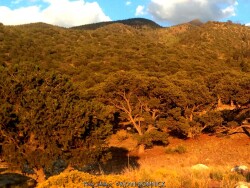

Plant Min Zone: 3b
Plant Max Zone: 6b
Sunlight: All Day Full Sun, Full Sun
Water / Rainfall: Very Low, Low
Soil Quality: Poor, Average
Bloom Season: None
Flower Color: None
Berry / Fruit Color: Brown-Beige
Spring Foliage Color: Dark Green
Summer Foliage Color: Dark Green
Fall Foliage Color: Dark Green
Evergreen Foliage: Yes
Winter Interest: Yes
Scented Flowers: No
Drought Tolerance: High
Wet-Feet Tolerance: Low
Humidity Tolerance: Low, Medium
Wind Tolerance: High
Poor Soil Tolerance: Sandy Soils, Rocky Soils, Shallow Soils, Alkaline Soils (high PH)
Height: 4' - 10'
Width: 4' - 10'
Growth Rate: Extremely Slow
Service Life: Very Long: 10-20 years
Maintenance Need: Low
Spreading Potential: Low
Yearly Trimming Tips: Slow Growing Shrub: No Trimming Needed for Many Years.
Plant Grouping Size: Specimen Planting of 1-3
Best Side of House: West Exposure
Extreme Planting Locations: Survives Severe Drought, Resistant to Rabbits, Crevice Gardens
Ornamental Features: Fine Texture, Exceptional / Colorful Foliage
Special Landscape Uses: None
Possible Pest Problems: Root Rot Disease, Insects
Plant Limitations: Environmental Stress / Decline, Slow to Reach Mature Size, Needs Excellent Drainage, Susceptible to Juglone / Black Walnut
Shippable in 2026: YES
The Pinon Pine (Pinus edulis) is a small to medium size tree, reaching 10-20 feet. It is native to the Southwest including Colorado, New Mexico, Arizona, and Utah at elevations of 4,000-7,000 feet. Most commonly found along dry foothills and mountain bases in well-drained rocky, sandy or clay soils. Pinyon Pine is extremely slow growing so be patient and you or the next homeowner will be rewarded with a beautiful dense pine tree. Actually, this pine is often planted as a small ornamental specimen "shrub" and best sited with room to eventually grow into a small tree after 50 years. In Kansas, this pine is ideal for hot and dry sites with marginal (dry/rocky) soil but intolerant of wet or irrigated soils. Planting on a berm or top of a retaining wall is recommended. This can be a substitute where Mugo pine would fail from heat and drought stress; good air circulation is needed to avoid foliage diseases and pests. This species is difficult to find. The edible seeds, known as pinyon pine nuts are a popular wild and commercial nut crop. Its wood is hard, heavy and very aronatic when smoldering in chimineas or outdoor fireplaces. Ultra cold-hardy plants from desert mountain climates normally dislike our humid summers and although we are on the Eastern edge of this plants humidity tolerance, it still survives reasonably well here.